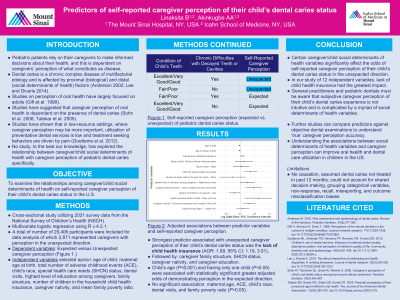Other
100 - Predictors of Self-Reported Caregiver Perception of Their Child’s Dental Caries


Brandon Linaksita, DDS, MPH Candidate (he/him/his)
Chief Pediatric Dental Resident
The Mount Sinai Hospital
The Mount Sinai Hospital
New York, New York, United States- AA
Aderonke A. Akinkugbe, BDS, MPH, PhD
The Mount Sinai Hospital
- AA
Aderonke Akinkugbe, BDS, MPH, PhD
Associate Professor, Dept. of Environmental Medicine and Public Health, Icahn School of Medicine
The Mount Sinai Hospital
New York, New York, United States - JM
Judy Moy, DMD
Chairman of the Department of Dentistry, Director of Dental Services, Mount Sinai Hospital
The Mount Sinai Hospital
New York, New York, United States
Presenting Author(s)
Co-Author(s)
Research Mentor(s)
Program Director(s)
Purpose: Pediatric patients are reliant on their caregivers’ perception of disease to make informed decisions about their health. The primary objective of this study was to examine the relationships among caregiver/child social determinants of health variables on self-reported caregiver perception of their child’s dental caries status in the U.S.
Methods: This cross-sectional study explored the associations between twelve social determinants of health predictor variables from the 2021 National Survey of Children’s Health and self-reported caregiver perception (expected vs. unexpected) of their child’s dental caries status using a multivariate logistic regression.
Results: Among 29,406 caregivers, approximately 10% (or 2,871) of caregivers demonstrated perception of their child’s dental caries status in the unexpected direction. The strongest predictor associated with unexpected perception was the lack of child health insurance (AOR: 1.89, 95% CI: 1.19, 3.01), followed by caregiver family structure (AOR: 1.60, 95% CI: 1.21, 2.11), special health care needs status of the child (AOR: 1.43, 95% CI: 1.16, 1.77), caregiver nativity (AOR: 1.36, 95% CI: 1.09, 1.70), and caregiver education (AOR: 1.27, 95% CI: 1.01, 1.60). In contrast, the child’s age (P < .001) and having only one child (P < .05) were associated with statistically significant greater adjusted odds of expected caregiver perception. Maternal age at birth, adverse childhood experiences, child’s race, dental visits, and family poverty ratio were not significantly associated with self-reported caregiver perception of their child's dental caries status (P>.05).
Conclusion: Certain caregiver/child social determinants of health variables such as child’s insurance status affect self-reported caregiver perception of their child’s dental caries status in the U.S. Understanding these relationships is crucial for improving children’s oral health.
Identify Supporting Agency and Grant Number: Research supported by the authors had no external funding, potential conflicts of interest, or financial support.

.jpg)